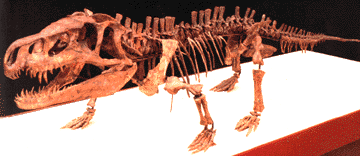
Garjainia
triplicostata -Huene, 1960- skeleton
Archosauria: Thecodontia: Proterosuchia:
Erytroshuchidae
Locality: Rassypnaya, Orenburg Region,
eastern European Russia
Age: Early Triassic, 240 million years ago
Meaning
of name: named after Dr. V Garjainov, Russian geologist
Size of a lion
From
the end of the Permian, large Paleozoic terrestrial predators
conceded their place
to thecodonts.
This was the premiere of the archosaurians, a very diverse and
numerous group which occupied a supreme position among terrestrial tetrapods during
the entire Mesozoic.
The exhibition presents a skull reconstruction of the most
ancient known
thecodont of the Late Permian genus Archosaurus.
Thecodonts
probably originated in some relatively high and dry environments
and were specialized
to feed on scaled reptiles.
There were no fangs in thecodonts, their sharp teeth
almost uniform in shape and size.
These teeth formed a saw adapted to cut rigid
but not too thick skin.
However when thecodonts came to occupy coastal lowlands,
they had to change their
prey, which caused modification in the structure of their
jaw and teeth.
In order to hunt for animals with a relatively soft thick skin,
such as dicynodonts,
the thecodont jaws stretched forward
and curved down,
while anterior teeth lengthened to help in tearing the flesh
of the victim.
Agile thecodonts were dangerous for sluggish and clumsy dicynodonts.
The
main protection of the last was a general increase in size, and by the late
Early
Triassic some dicynodonts got as large as modern rhinoceroses.
But
the increase in size in hervivorous animals is always accompanied by
a parallel
increase in size of the predators hunting for them.
Therefore simultaneously with
large dicynodonts, very large flesh-eating
thecodonts existed,
for example, of the genus Garjainia.
Garjainia was a very primitive member of
the Thecodontia.
This name derives from the fact that the teeth are rooted in
deep sockets.
Thecodonts led to most groups of later reptiles, the archosaurs.
They
replaced the ruling mammal-like reptiles, the therapsids.
Garjainia was a definitelycarnivore.
Its similarity to
some of the highly specialized carnivorous mammal-like reptiles
is compelling.
By the end of the Triassic period, the mammal-like reptiles had
been driven close
to extinction. The world was overtaken by the sucessors of thecodonts,
which
includes the dinosaurs, which prospered over the next 140 million years.






